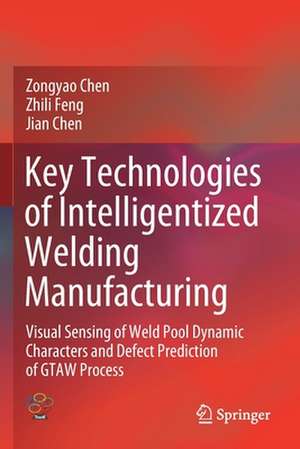Key Technologies of Intelligentized Welding Manufacturing: Visual Sensing of Weld Pool Dynamic Characters and Defect Prediction of GTAW Process
Autor Zongyao Chen, Zhili Feng, Jian Chenen Limba Engleză Paperback – 15 iul 2021
| Toate formatele și edițiile | Preț | Express |
|---|---|---|
| Paperback (1) | 631.40 lei 6-8 săpt. | |
| Springer Nature Singapore – 15 iul 2021 | 631.40 lei 6-8 săpt. | |
| Hardback (1) | 637.46 lei 6-8 săpt. | |
| Springer Nature Singapore – 15 iul 2020 | 637.46 lei 6-8 săpt. |
Preț: 631.40 lei
Preț vechi: 742.82 lei
-15% Nou
Puncte Express: 947
Preț estimativ în valută:
120.86€ • 131.32$ • 101.59£
120.86€ • 131.32$ • 101.59£
Carte tipărită la comandă
Livrare economică 21 aprilie-05 mai
Preluare comenzi: 021 569.72.76
Specificații
ISBN-13: 9789811564932
ISBN-10: 9811564930
Ilustrații: XIII, 95 p. 87 illus., 70 illus. in color.
Dimensiuni: 155 x 235 mm
Greutate: 0.17 kg
Ediția:1st ed. 2021
Editura: Springer Nature Singapore
Colecția Springer
Locul publicării:Singapore, Singapore
ISBN-10: 9811564930
Ilustrații: XIII, 95 p. 87 illus., 70 illus. in color.
Dimensiuni: 155 x 235 mm
Greutate: 0.17 kg
Ediția:1st ed. 2021
Editura: Springer Nature Singapore
Colecția Springer
Locul publicării:Singapore, Singapore
Cuprins
Introduction.- Monitoring of Weld Pool Surface with Active Vision.- Visual Sensing of 3D Weld Pool Geometry with Passive Vision.- Penetration prediction with data driven models.- Penetration Control for Bead-on plate weld.- Penetration Detection and Control Inside U-groove.- Lack of fusion detection inside narrow U-groove.- Measuring Material Deformation using Digital Image Correlation.- Conclusions.
Notă biografică
Dr. Zongyao Chen received his B.S. and M.S. in Electrical Engineering in 2009 and 2012 from Shanghai Jiaotong University. He received his Ph.D. from the University of Tennessee in November 2018. During his Ph.D. study, he worked with the welding and joining research group at oak ridge national lab and focused on applying artificial intelligence and computer vision technology to welding manufacturing and proposed the Reversed Electrode Image (REI) method to extract the features and penetration of welding pool during GTAW process in his doctoral dissertation. He is currently working as a Research Scientist at the R&D Centre of Air Liquide in Delaware, USA. Dr. Chen’s research interests include robotics, welding automation, computer vision, machine learning and other AI applications in industry.
Dr. Feng is a Group Leader of Materials Processing and Joining Group and a Distinguished R&D Staff of Oak Ridge National Laboratory. He manages a diverse R&D portfolio aimed at addressingthe materials processing and joining needs from automotive, aerospace, nuclear, petrochemical and power generation industries. His primary interest is in thermal–mechanical–metallurgical behaviors of materials during processing and joining. Most recent work included integrated computational welding engineering (ICWE), proactive weld residual stress control and management, friction stir welding and processing, characterization of weld by advanced neutron and synchrotron scattering, and novel solid-state joining processes of dissimilar metals. Dr. Feng received his Ph.D. in Welding Engineering from the Ohio State University. He is a Fellow of the American Welding Society, a Joint Faculty Professor,Department of Mechanical, Aerospace, and Biomedical Engineering, University of Tennessee, Knoxville, and Guest Professor of Tsinghua University. Dr. Feng has broad interactions with industry and extensive experience in solving critical industry problems.Dr. Feng is currently one of Editors-in-Chief Transactions on Intelligent Welding Manufacturing (TIWM) authorized by Springer for periodical publication of research papers from 2017.
Dr. Jian Chen is a Research Staff in Materials Processing and Joining Group at Oak Ridge National Laboratory. He has significant experimental and analytical experiences in developing advanced materials joining and processing technologies and the associated control and monitoring techniques. His current R&D focuses on advanced welding and joining techniques, intelligent welding process monitoring and control, non-destructive weld quality inspection and high-performance welding simulation. Dr. Chen received his doctoral degree in Industrial Engineering from the Ohio State University. He is a member of American Welding Society’s Technical Papers Committee and 2nd Vice Chair of American Welding Society’s North East Tennessee Section.
Dr. Jian Chen is a Research Staff in Materials Processing and Joining Group at Oak Ridge National Laboratory. He has significant experimental and analytical experiences in developing advanced materials joining and processing technologies and the associated control and monitoring techniques. His current R&D focuses on advanced welding and joining techniques, intelligent welding process monitoring and control, non-destructive weld quality inspection and high-performance welding simulation. Dr. Chen received his doctoral degree in Industrial Engineering from the Ohio State University. He is a member of American Welding Society’s Technical Papers Committee and 2nd Vice Chair of American Welding Society’s North East Tennessee Section.
Textul de pe ultima copertă
This book describes the application of vision-sensing technologies in welding processes, one of the key technologies in intelligent welding manufacturing. Gas tungsten arc welding (GTAW) is one of the main welding techniques and has a wide range of applications in the manufacturing industry. As such, the book also explores the application of AI technologies, such as vision sensing and machine learning, in GTAW process sensing and feature extraction and monitoring, and presents the state-of-the-art in computer vision, image processing and machine learning to detect welding defects using non-destructive methods in order to improve welding productivity. Featuring the latest research from ORNL (Oak Ridge National Laboratory) using digital image correlation technology, this book will appeal to researchers, scientists and engineers in the field of advanced manufacturing.
Caracteristici
Provides a comprehensive overview of non-destructive methods for detecting and reducing welding defects during gas tungsten arc welding (GTAW) based on computer vision and artificial intelligence Presents research on visual sensing and control of GTAW Discusses real-time welding quality control to reduce various welding defects
